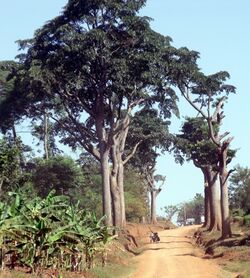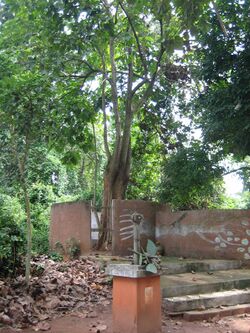Biology:Iroko
| Iroko | |
|---|---|

| |
| Milicia excelsa, Uganda | |
| Scientific classification | |
| Kingdom: | Plantae |
| Clade: | Tracheophytes |
| Clade: | Angiosperms |
| Clade: | Eudicots |
| Clade: | Rosids |
| Order: | Rosales |
| Family: | Moraceae |
| Tribe: | Moreae |
| Genus: | Milicia Sim |
| Species | |
Iroko (also known as ọ́jị̀ in Igbo language, uloho in the Urhobo language of Southern Nigeria, and as odum in the Kwa languages of Ghana[1]) is a large hardwood tree from the west coast of tropical Africa that can live up to 500 years.[2] This is the common name for the genus Milicia, in which there are two recognized species, which are closely related: Milicia excelsa and Milicia regia.[3]
The genus name of Milicia is in honour of Milici (19th and 20th centuries), an administrator in Portuguese East Africa (in modern-day Mozambique) who supported the work of the author of the genus, Thomas Robertson Sim.[4] It was first described and published in Forest Fl. Port. E. Afr. on page 97 in 1909.[5]
The tree is known to the Yoruba as ìrókò, logo or loko and is believed to have healing properties.[6] Iroko is known to the Igbo people as ọjị wood.[7] It is one of the woods sometimes referred to as African teak,[8] although it is unrelated to the teak family. The wood colour is initially yellow but darkens to a richer copper brown over time.
Species
Iroko is yielded mostly (probably) by Milicia excelsa. In much of the literature on this timber the names of the trees that yields it are given as Chlorophora excelsa (syn. Milicia excelsa) and Chlorophora regia (syn. Milicia regia).[9][10]
Milicia excelsa is currently listed as 'lower risk/near threatened' on the IUCN Red List.[11]
Both species are dioecious, with male and female flowers on separate individuals.[12]
Uses
The timber is used for a variety of external and internal purposes[13] including boat-building, domestic flooring, furniture and outdoor gates. From the late 1990s, it was used as part of the txalaparta, a Basque musical instrument constructed of wooden boards, due to its lively sound.[14] Iroko is one of the traditional djembe woods. Iroko wood was the wood chosen for the pews in the Our Lady of Peace Basilica.[15]
It is a very durable wood;[16] iroko does not require regular treatment with oil or varnish when used outdoors, although it is very difficult to work with tools as it tends to splinter easily, and blunts tools very quickly.[17]
In the UK there are no trade restrictions on the machining of this timber. The only reported adverse effects known to be caused by the dust from iroko are asthma, dermatitis and nettle rash.[18]
Cultural beliefs
The tree is feared in some cultures where it originates and hence is shunned or revered with offerings.[19] Yoruba people believe that the tree is inhabited by a spirit, and anybody who sees the Iroko-man face to face becomes insane and speedily dies.[20] According to the Yoruba, any man who cuts down any iroko tree causes devastating misfortune on himself and all of his family,[20] although if they need to cut down the tree they can make a prayer afterwards to protect themselves.[21]
They also claim that the spirit of the Iroko can be heard in houses which use iroko wood, as the spirit of the Iroko is trapped in the wood.[20] In Nigeria the iroko wood is of much lower quality due to soil conditions as well as root-rot.[22][23][24] Some Westerners refer to the wood as "poor man's teak".[25]
Gallery
- Milicia Excelsa (''Chlorophora excelsa'') (Bangla - আফ্রিকান টিকওক).jpg
Trunk of iroko / African teak, Milicia excelsa (Chlorophora Excelsa) in Lawachara National Park, Bangladesh. 2016.
References
- ↑ Blench, Roger (2006). Archaeology, language, and the African past. Altamira Press. ISBN 9780759104655.
- ↑ Amadi, Pete (2013-09-01) (in en). Conflicted Destiny: Chronicle of a Natural Born Warrior. FriesenPress. ISBN 9781460224274. https://books.google.com/books?id=ezvpAwAAQBAJ.
- ↑ D.A. Ofori; M.D. Swaine; C. Leifert; J.R. Cobbinah; A.H. Price (December 2001), "Population genetic structure of Milicia species characterised by using RAPD and nucleotide sequencing L.", Genetic Resources and Crop Evolution 48 (6): 637–647, doi:10.1023/A:1013805807957
- ↑ Burkhardt, Lotte (2018). "Verzeichnis eponymischer Pflanzennamen - Erweiterte Edition. Index of Eponymic Plant Names - Extended Edition. Index de Noms éponymiques des Plantes - Édition augmentée" (in German) (pdf). Verzeichnis eponymischer Pflanzennamen – Erweiterte Edition. Berlin: Botanic Garden and Botanical Museum, Freie Universität Berlin. doi:10.3372/epolist2018. ISBN 978-3-946292-26-5. https://doi.org/10.3372/epolist2018. Retrieved 1 January 2021.
- ↑ "Milicia Sim | Plants of the World Online | Kew Science" (in en). https://powo.science.kew.org/taxon/urn:lsid:ipni.org:names:40890-1.
- ↑ Oduyoye, Modupe (2015-09-29) (in en). The Sons of the Gods and the Daughters of Men: An Afro-Asiatic Interpretation of Genesis 1-11. Wipf and Stock Publishers. ISBN 9781498235822. https://books.google.com/books?id=6HmoCgAAQBAJ.
- ↑ Onunwa, Udobata R. (2010-06-27) (in en). A Handbook of African Religion and Culture. Dorrance Publishing. ISBN 9781434953964. https://books.google.com/books?id=LPqZQYiF4jEC.
- ↑ Stephen (2023-06-14). "Iroko Wood Is African Teak Lumber 2023" (in en-US). https://commercialforestproducts.com/iroko-wood-teak-lumber/.
- ↑ iroko wood, Encyclopædia Britannica on-line
- ↑ Chlorophora excelsa (Welw.) Benth., Taxonomic Serial No.: 506548, Integrated Taxonomic Information System
- ↑ "The IUCN Red List of Endangered Species: Milicia excelsa", The IUCN Red List of Endangered Species
- ↑ Daïnou, K.; Mahy, G.; Duminil, J.; Dick, C. W.; Doucet, J-L; Donkpégan, A S L.; Pluijgers, M.; Sinsin, B. et al. (2014). "Speciation slowing down in widespread and long-living tree taxa: Insights from the tropical timber tree genus Milicia (Moraceae)". Heredity 113 (1): 74–85. doi:10.1038/hdy.2014.5. PMID 24549110.
- ↑ "Wood Species Database: Iroko". Timber Research And Development Association (TRADA). https://www.trada.co.uk/wood-species/iroko/.
- ↑ "La txalaparta, el sonido ancestral de Euskadi por Pol Ducable Rogés". http://www.cancioneros.com/co/2839/2/la-txalaparta-el-sonido-ancestral-de-euskadi-por-pol-ducable-roges.
- ↑ Elleh, Nnamdi (2002-01-01) (in en). Architecture and Power in Africa. Greenwood Publishing Group. ISBN 9780275976798. https://books.google.com/books?id=aKoKHmuexywC.
- ↑ Kurjatko, Stanislav; Kúdela, Jozef; Lagaňa, Rastislav (2006-01-01) (in en). Wood Structure and Properties '06. Arbora Publishers. ISBN 9788096886845. https://books.google.com/books?id=VfuWr1KxrGYC.
- ↑ Westin, Mike (2013-04-12) (in en). Upgrading Your Boat's Interior. A&C Black. ISBN 9781408159095. https://books.google.com/books?id=HikdloJ3Z2gC.
- ↑ "HSE Toxic Woods Information Sheet". Health and Safety Executive. http://www.hse.gov.uk/pubns/wis30.pdf.
- ↑ Twilight Tales3. CUP Archive. 1953. p. 26. https://books.google.com/books?id=zHw9AAAAIAAJ&pg=PA26. Retrieved 2 April 2011.
- ↑ 20.0 20.1 20.2 Ogumefu, M. I. (1929). Yoruba legends. Forgotten Books. p. 10. ISBN 978-1-60506-017-0. https://books.google.com/books?id=c2nt2Vui0qEC&pg=PA10.
- ↑ (in en) The Church Missionary Juvenile Instructor. Seeley, Jackson, & Halliday. 1880-01-01. https://archive.org/details/churchmissionar01socigoog.
- ↑ (in en) Bulletin of the Imperial Institute. The Institute. 1914-01-01. p. 366. https://books.google.com/books?id=AOsiAQAAIAAJ.
- ↑ Commons, Great Britain Parliament House of (1914-01-01) (in en). House of Commons Papers. H.M. Stationery Office. https://books.google.com/books?id=yeoLAQAAIAAJ.
- ↑ (in en) Documentation and Information: Ecology : Catalogue of Documents and Publications on MAB in Africa. UNESCO's Regional Office. 1990-01-01. https://books.google.com/books?id=zhsoAQAAMAAJ.
- ↑ Hamon, Lindsay (2012-11-07) (in en). When God Takes Over: Stories of hope on the streets. AuthorHouse. ISBN 9781477238844. https://books.google.com/books?id=OblmwE2bFswC.
External links
- Toxic woods (HSE)
Wikidata ☰ Q144717 entry
 |



